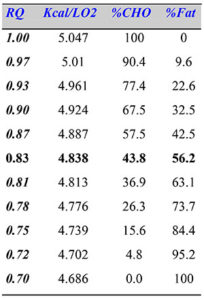
Fat Burning Zone Myth
One Of the Biggest Myths Around:
Lower intensity exercise puts you in the fat-burning zone, so it’s preferable to higher intensity exercise. So basically working out “less hard” is better than working out “more hard.” Think about that for a minute, does that make sense?
I was asked a question about the fat burning zone the other day by one of my clients and I was surprised she didn’t know this was a myth. I take great pride in educating during our sessions so to say the least I was a caught off guard. It made me do a little self reflection as to how I am educating my clients when I train them – apparently I need to do more reminders and explanations for them if the fat burning zone was brought up.
What Is The Fat Burning Zone?
The fat burning zone is a heart rate zone typically while performing some type of cardio that is low-intensity exercise (<40% VO2max). Typically, to be “exercising” in this zone the one exercising is working out at a pretty low intensity.
The myth behind this is the body burns greater amounts of fat in this range. This myth has been perpetuated by many sources of health and fitness information. It is found on most fitness-equipment guidelines. Look at the displays on the latest exercise equipment and you will see different “training zones” recommended for fitness and calorie burning.
Spoiler Alert
These zones are largely BS. It’s not surprising this myth has lasted so long though. Unfortunately, most people like the idea that lower-intensity exercise could actually be better for you than sweat inducing higher intensities. Heck, who doesn’t like the idea of working less hard being better for you?
Question for you: When exercising would it be more beneficial to burn more calories or fewer calories when trying to lose weight? Think about that for a bit. Of course the idea would be to burn more calories.
Science
The metabolism of fat during exercise is a complicated process regulated by multiple hormones.
First understand that fat used for energy is drawn from two different sources:
- Subcutaneous Adipose Tissue
- Intramuscular Stores of Triglycerides
Stored intramuscular triglycerides are the main source during moderate to higher intensities of exercise. As exercise intensity increases, our usage of fat for energy peaks and then decreases. When does that peak occur? During lower or higher intensities of exercise? The myth and truth lie somewhere in between.
Much of the confusion regarding the optimal intensity to burn maximal fat comes from understanding and applying the non-protein caloric equivalents for RQ (respiratory quotient) chart (Figure 1). This chart details the amount of calories expended per liter of oxygen consumed at a given RQ. The RQ is calculated by dividing the amount of CO2 produced and O2 consumed at rest or during exercise. This value can then tell us the relative contributions of fat and carbohydrate to total energy expenditure.

Figure 1: RQ CHart
For instance, at a RQ of 0.83, the percentage of total calories coming from fat and carbohydrate are 56.2% and 43.8%.
As RQ increases or decreases from this value, the percentages change. Individuals who perpetuate this myth claim that this chart proves that low-intensity exercise (below RQ of 0.83) will burn more fat because the percent contribution from fat is higher.
This is actually true, however, would you rather burn fat at a rate of 60% and only burn 100 calories, or burn fat at a 40% rate and burn 200 calories in the same time period (say 15 minutes)?
Lets Do Elementary School Level Math:
60% of 100 calories is 60 calories from Fat.
40% of 200 calories is 80 calories from Fat.
The problem is that total calories are lower at this intensity. Therefore, the total amount of fat burned is actually lower compared to higher intensities (greater total calories burned and thus more fat) for the same duration of exercise.
At What Intensity Does The “Fat Burning Zone” Occur?
Researchers have identified where peak fat oxidation in the muscle occurs as a percentage of VO2max. This point is roughly 65% VO2max with decreased oxidation at about 85% VO2max. Maximum fat oxidation occurs at about 55 to 72% VO2max. Fat oxidation falls off quickly beyond intensities of about 75% VO2max or greater.
According to large amounts of past research, if we had to identify a “fat-burning zone,” it would be at about 65% or within the range of 55 to 72% VO2max. Exercising at this level is equivalent to moderate/vigorous exercise intensities.
Additionally, to improve our muscles ability to oxidize fat at rest and during exercise, one must positively enhance mitochondrial density and function. This is best accomplished through interval training. Interval training is working at a very high level, not a low level.
Aerobic / Cardio Program Recommendation
Aerobic-program recommendations to augment caloric expenditure (and fat oxidation) during exercise would be to include a MINIMUM of 2 – 3days of moderate-intensity, longer-duration (45 to 60 minutes) workouts combined with 1 – 2 days of interval training. This combination program will provide opportunities for maximizing caloric expenditure (at a moderate intensity) and improving the metabolic function of the muscle (interval training) and overall fitness.
The Bottom Line:
THE FAT BURNING ZONE AT LOW INTENSITIES OF EXERCISE DOES NOT EXIST!
The best approach is to think of energy expenditure as a calorie is a calorie is a calorie, rather than partitioning into carbohydrate and fat calories. To burn maximum calories in support of ongoing weight loss, progress to a moderate-intensity/higher-volume exercise program and include interval training.
Did this help? Got more questions? We got answers! Give us a call or email. Check us out at www.LakeCountryTraining.com
We specialize at in home personal training. We would love to help you!
Thanks!



